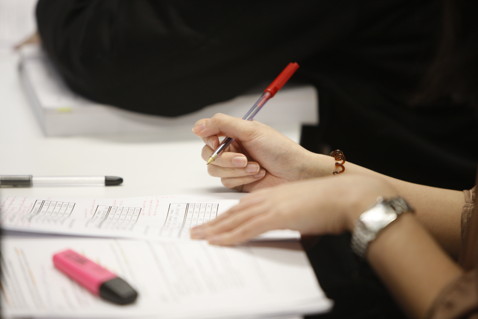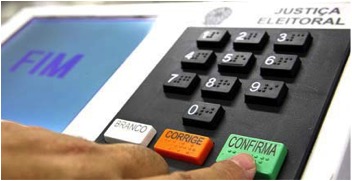As part of the ongoing “Great Lecture Notes Debate” we hear from Dr Colleen McKenna, Departmental Adviser to the Department of International Development in the LSE Teaching and Learning Centre. Colleen has explored the educational research on how different approaches to handouts stimulate student engagement in lectures and are thought to support student learning and achievement.

I have enjoyed the rich discussion so far in ‘The Great Lecture Notes Debate’ and would like to thank Professor Jean Paul Faguet for the invitation to contribute to this discussion. In this post, I will consider note-taking in relation to:
1) student learning
2) differently configured handouts (e.g. full lecture notes, partial notes and skeleton notes) and
3) the structure and pace of lectures themselves.
The function of taking notes
Why should we encourage note taking?
The research tends to suggest that note taking has different functions in terms of learning. Two such functions are ‘encoding’ in which students come to ‘own’ the material they’re engaging with in a lecture or, indeed, that which they are reading. A second function of note taking is sometimes termed ‘storage’ and this refers to the retention of material over time. However, the literature suggests that the extent to which encoding and retention are realised depends on a number of contextual factors including the quality of the notes that are taken; the speed and organisation of the lecture; the opportunities for students to reflect on their notes; and the combination of student notes with scaffolding devices – such as outlines or overviews.

Combining note taking with handouts
There is broad consensus in the literature that students’ own notes are more effective (both in terms of learning in the lecture and reviewing the material at a later stage) when combined with some sort of framing device (e.g. a handout/slides/advance email) that outlines the key points and provides an overview of the lecture. (See, for example, DeZure et al., 2001 – link below).
However, the provision of a full set of lecture notes such as a ‘script’ of the lecture, has generally been found NOT to be as helpful for learning. For example, Russell et al. (1983) studied both student preferences for different types of handouts as well as student performance. In this study, groups of medical students were allocated 3 different types of handouts:
- complete (nearly word for word transcript);
- partial (objectives, outline of topics plus all tables and figures) and
- skeletal (outline containing objectives and brief list of subtopics).
Students were then examined on the lecture content 2-4 weeks following the lecture and again 3 months later. Students expressed a strong preference for receiving the very detailed lecture handouts; however, the researchers found that when students had access to a complete set of lecture notes, they took fewer notes themselves and, more importantly, their performance in relation to encoding and retention declined, particularly for material introduced in the last quarter of the lecture.
Students who were given partial or skeleton handouts tended to perform better on the exams than those who received complete lecture notes. Students with the partial or skeleton handouts wrote more notes, used complete sentences and made more extensive comments. (In this study, the authors tentatively suggest that the ‘partial’ handout used in conjunction with students’ own notes was the optimum combination for learning.)

Note taking and lectures
Not surprisingly, the organisation and delivery of lectures can influence student note taking and learning. In their review of the literature on note taking, DeZure et al. (2001) suggest that practices within lectures can help students take notes that are meaningful and in such a way that they are not simply transcribing what they hear. (This type of behaviour leads to cognitive overload and makes it harder for students to listen and engage with the material within the session.)
It is suggested that students are more able to take useful notes in a lecture when:
- the pace is slow enough that students can both take notes and process what is being said
- there are pauses (2-3 minutes) built in midway through and at the end for students to consolidate their notes and write any immediate observations. (Bonwell and Eison, 1991 argue that such pauses ‘significantly’ improve comprehension and retention.)
- verbal and visual cues are used by the lecturer to underscore the organisation of the material and to help students identify hierarchical relationships, key concepts, overarching arguments, etc. (DeZure et al., 2001.)
In many ways, these ideas intersect with Neil McLean’s reflections in his recent LSE Teaching blog post, Observations on observations, which looks at his experiences of observing lectures over the past term.
So, those are a few thoughts from me. Of course, context is important in terms of how we choose to support and stimulate students’ learning in lectures, and clearly there are multiple ways to do this. Conversations, such as the one on this blog, help to communicate the rationale(s) behind the different ways of approaching handouts and they help signal how different practices motivate learning.
Finally, as an aside, there is also recent research suggesting that writing notes by hand has more educational benefits than typing notes on a computer (Mueller & Oppenheimer, 2014), because in the latter, students tend to type up information verbatim rather than processing it and framing it in their own terms. However, that’s for another discussion!
Dr Colleen McKenna, TLC Departmental Adviser to the Department of International Development. Please feel free to get in touch with me at c.mckenna4@lse.ac.uk or to browse the Teaching and Learning Centre’s web pages for academic staff, which may be of interest.
References:
Bonwell, C. & Eison, J. (1991) Active Learning: Creating excitement in the classroom. Washington: George Washing University. Cited in DeZure, et al. (2001).
DeZure, D., Kaplan, M., & Deerman, M. (2001) ‘Research on student notetaking: implications for faculty and graduate student instructors’. Centre for Research on Learning and Teaching: Occasional Papers No. 16. Michigan. (This is a particularly useful review of the literature with a number of practical suggestions for lecturers as well as an appended student guide to effective note taking and review.) http://www.crlt.umich.edu/sites/default/files/resource_files/CRLT_no16.pdf
Mueller, P. & Oppenheimer, D. (2014) ‘The Pen Is Mightier Than the Keyboard
Advantages of Longhand Over Laptop Note Taking’. Psychological Science. June 2014 25: 1159-1168.
Russell, I., Caris, T., Harris, G., & Hendrickson, W. (1983) ‘Effects of three types of lecture notes on medical student achievement’. Journal of Medical Education. 58: 627-636.
Related Posts
- The Great Lecture Notes Debate
- The Great Lecture Notes Debate Part Two – The Case Against; Notes vs. Knowledge
- The Great Lecture Notes Debate Part Three – The Case For; the lecturers’ view
- The Great Lecture Notes Debate Part Four – The student point of view






Very informative summary of research on the topic — thank you for that Colleen!